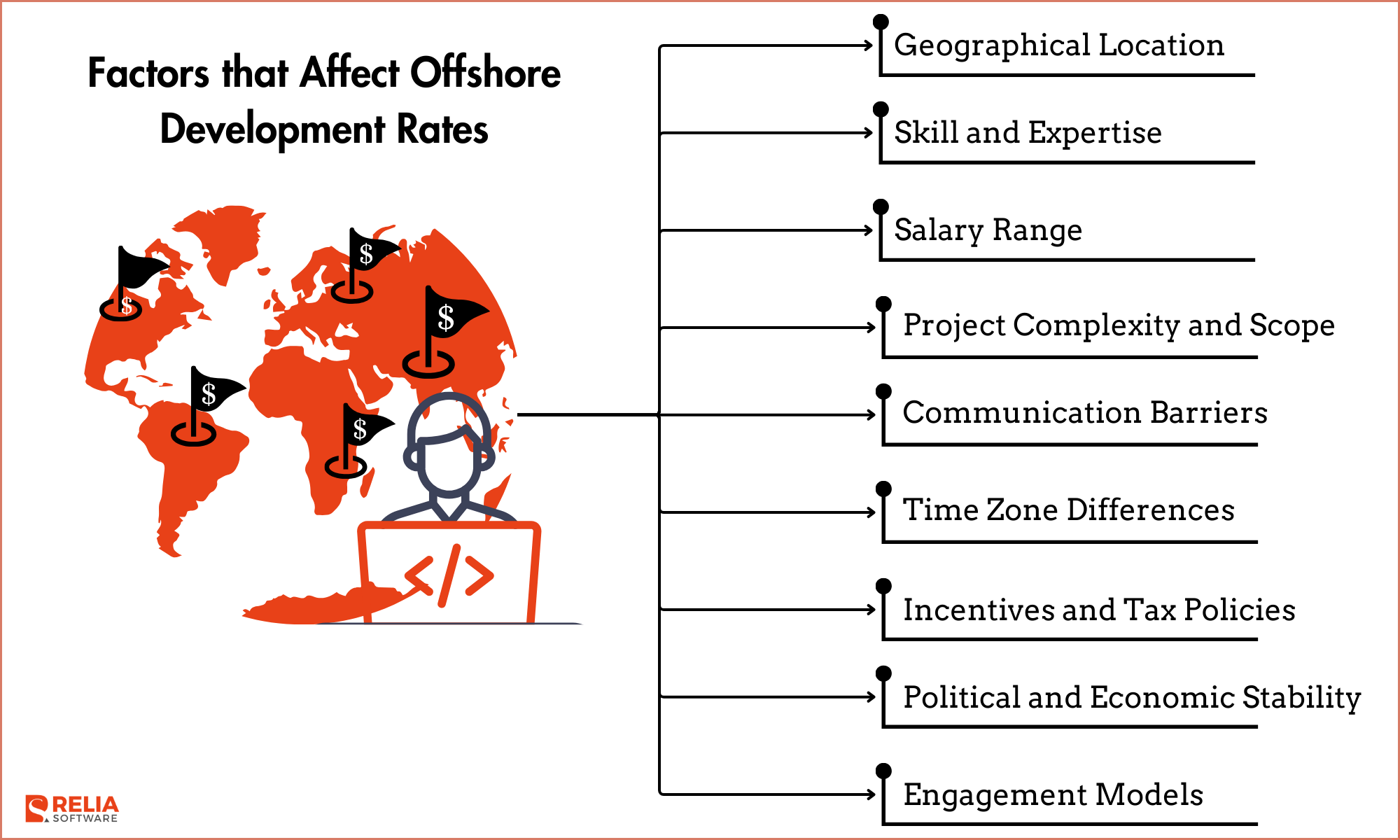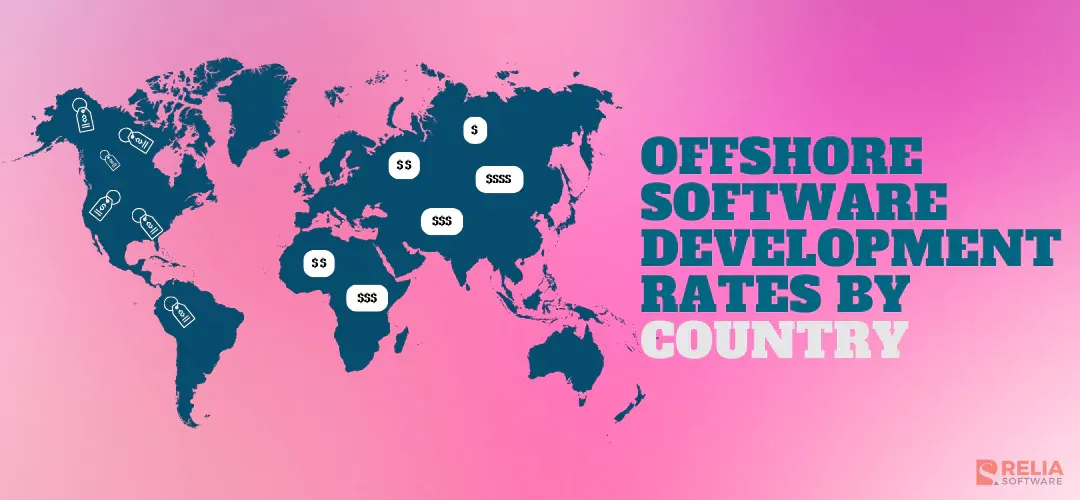As technology continues to drive global business expansion, companies are increasingly turning to offshore software development to access skilled talent and cost-effective solutions. Offshore development offers the advantage of tapping into a diverse talent pool while optimizing budgets for IT projects. In 2025, offshore software development rates across different countries have evolved in response to economic shifts, skill availability, and industry demand.
This article delves into a comprehensive analysis of offshore software development rates by country, providing businesses with valuable insights to make informed decisions when outsourcing their software development needs.
>> Read more: Breakdown of Hiring An Offshore Software Development Team
Factors that Affect Offshore Development Rates
Offshore software development rates refer to the cost of hiring software developers or services in a foreign country, typically where labor costs are lower than in the client’s home country. The rates for offshore software development services can vary widely depending on several factors.
Geographical Location
The geographical location of the offshore software development company plays a crucial role in determining the rates. Offshore destinations in Asia, such as India, the Philippines, and Vietnam, are known for offering competitive pricing due to lower labor costs and a large pool of skilled developers.
Eastern European countries, like Ukraine and Poland, also offer attractive rates while maintaining a reputation for high-quality software development. On the other hand, countries with a higher cost of living and greater demand for technology services tend to have higher rates, like the US, Canada, etc.
Skill and Expertise
The skill level and expertise of the offshore software developers are significant factors in pricing. Highly skilled professionals with specialized knowledge and experience in cutting-edge technologies often charge premium rates.
Companies with a strong track record of delivering successful projects and possessing industry-specific expertise may also charge more for their services. While opting for less experienced developers might lead to cost savings, it could potentially compromise the quality of the final product.
Salary Range
Average national wages are used to determine the rates. Salary figures from different locations can be compared by converting them to the same international currency. The salary range is based on the going rate for labor in that country. Offshore software development costs more money when salaries are greater.
Project Complexity and Scope
The complexity and scope of the software development project directly impact the rates. Large-scale, intricate projects that require extensive planning, research, and technical prowess are likely to come with higher costs. Additionally, projects with constantly evolving requirements or tight deadlines may require more resources and, consequently, higher rates to meet the demands effectively.
Communication and Language Barriers
Effective communication is vital for successful offshore software development. Companies that offer seamless communication through various channels, such as video conferencing, chat, and email, often have a competitive advantage. Language barriers can also impact rates, as language proficiency affects the efficiency of the development process and the ability to understand project requirements clearly.
Time Zone Differences
Offshore software development often involves collaboration between teams located in different time zones. While this can be advantageous for round-the-clock development, it may also lead to scheduling challenges and potential delays in addressing critical issues. Companies that can adapt to the time zone differences efficiently and ensure continuous progress might be priced differently than those that struggle to manage this aspect effectively.
Incentives and Tax Policies
The expense of offshore development can be mitigated by the tax exemptions and other financial incentives offered by the government to software developers working abroad.
The cost of doing business for software development companies might rise if tax rates are raised. As a result, they will demand increased prices to cover the cost of taxes and ensure continued profitability.
Political and Economic Stability
The political and economic stability of the offshore location can influence rates significantly. Regions experiencing political unrest or economic uncertainty may have a higher perceived risk for businesses. As a result, offshore development companies operating in such areas might increase their rates to compensate for potential risks and uncertainties.
Engagement Models
The duration and pricing structure of your project's engagement model can have a significant impact on its overall cost. Opting for a non-fixed pricing model for long-term projects may lead to unpredictable fluctuations in the final development service costs.
Choosing the right engagement model is vital to optimize cost-effectiveness and ensure maximum value for your investment. Considering how the engagement model influences hourly rates is essential in selecting development specialists to have high-quality solutions within your budget.

Offshore Software Development Rates by Country
The data used in this analysis is sourced from reputable platforms such as PayScale, SalaryExpert, Indeed, Glassdoor, Upwork, TopTal, YouTeam, Jobicy, and more.
Before going into rates by country, below is an overview of the average software development hourly rates and related metrics for different regions:
|
Region |
Hourly Rate |
Ease of Doing Business* |
Political Stability** |
|
North America |
$70 – $140 |
84 |
0.47 |
|
Western Europe |
$35 – $95 |
80.3 |
0.47 |
|
Eastern Europe |
$25 – $65 |
73.7 | |
|
Latin America |
$20 – $60 |
65.7 |
-0.17 |
|
Asia Pacific |
$20 – $50 |
65.5 |
-0.37 |
|
Africa |
$18 – $40 |
66.1 |
-0.68 |
|
Australia |
$50 – $90 |
81.2 |
0.88 |
|
New Zealand |
86.8 |
*According to The World Bank, the max score is 100.
**According to theglobaleconomy.com, scale from -2.5 to 2.5.
Please bear in mind that average rates can be misleading, and the actual price for offshore software development services may differ significantly due to several reasons like technologies, level of developer experience, and in-demand skills. Let's check the rates of outstanding countries in each region.
North America
Small and medium-sized enterprises (SMEs) and new ventures are increasingly locating their operations in North America. Nonetheless, studies show that developers in this area earn the greatest wages overall.
| Country | Average Hourly Rate |
| The United States | $70 – $200 |
| Canada | $50 – $180 |
Here’s a breakdown of average offshore software development rates in American big cities:
| City | Average Hourly Rate |
| California | $80 |
| Texas | $50 |
| New York | $65 |
| Washington | $60 |
Western Europe
Top offshore software development countries are in Western Europe. This area is almost as expensive as the US due to its high cost of living, complicated tax structure, and tight building regulations.
Average software engineer salary is $60k, with offshore software development rates by nation ranging from $35 to $95. Because taxes, insurance, and other legal expenses comprise 35% of the net wage, allowances that aren't included will cost a lot.
Western European offshore development may cost more, however quality, creativity, and teamwork may offset the costs for certain projects. You must compare these elements against your project needs and budget to make an informed conclusion.
|
Country |
Average Hourly Rate |
|
United Kingdom |
$40 - $100 |
|
Germany |
$35 - $90 |
|
France |
$30 - $60 |
|
Netherlands |
$54 - $163 |
|
Switzerland |
$54 - $73 |
|
Belgium |
$36 - $49 |
|
Sweden |
$40 - $54 |
|
Denmark |
$42 - $57 |
Offshore Software Development Hourly Rates by Country in Eastern Europe
Eastern Europe is known for its IT expertise and startup culture. Eastern European professionals know full-stack technologies including C/C++, Java, and JavaScript, .NET, Python, and other programming languages attract international consumers.
Software engineering services cost $15–25 per hour. The average developer pay is $20k to $50k.
| Country | Average Hourly Rate |
| Ukraine | $25 - $55 |
| Poland | $27 - $37 |
| Romania | $25 - $45 |
| Hungary | $23 - $32 |
| Bulgaria | $21 - $29 |
| Belarus | $6 - $11 |
| Serbia | $30 - $70 |
Offshore Software Development Hourly Rates by Country in Latin America
Developers from Latin America are in high demand because of the region's well-deserved reputation for providing competitive wages without sacrificing product quality. Hotspots for software development outsourcing include countries like Mexico, Brazil, Argentina, Colombia, and Uruguay.
Average software development costs among Latin American nations are as follows:
| Country | Average Hourly Rate |
| Mexico | $20 - $35 |
| Brazil | $25 - $50 |
| Argentina | $19 - $25 |
| Colombia | $18 - $25 |
| Chile | $20 - $28 |
| Peru | $25 - $60 |
| Uruguay | $30 - $55 |
| Costa Rica | $34 - $47 |
Offshore Software Development Hourly Rates by Country in Asia
Asia has the most offshore software developers and leads the software outsourcing sector. Asia has several countries and economical and expensive offshore destinations for outsourced development.
| Country | Average Hourly Rate |
| India | $15 - $30 |
| China | $20 - $40 |
| Singapore | $40 - $62 |
| Philippines | $5 - $14 |
| Vietnam | $10 - $30 |
| Bangladesh | $5 - $12 |
| Indonesia | $7 - $16 |
| Malaysia | $15 - $25 |
>> Read more: How To Set Up An Offshore Development Center In Vietnam?
Offshore Software Development Hourly Rates by Country in Africa
Although the African IT outsourcing sector is young, it is already growing and attracting foreign clients. The region's rising young population is predicted to enhance demand for high-quality service sector jobs, propelling it to the top software developer countries in 2025.
African web and mobile app development is cheaper than US and European prices because the region is just entering the software development sector. The industry's rapid growth will change the range.
| Country | Average Hourly Rate |
| South Africa | $40 - $50 |
| Egypt | $12 - $19 |
| Morocco | $12 - $16 |
| Nigeria | $30 - $50 |
| Kenya | $15 - $33 |
| Uganda | $13 - $40 |
| Tunisia | $8 - $24 |
Offshore Software Development Hourly Rates by Country in Australia and New Zealand
>> Read more:
- Top 7+ Mobile App Development Companies In Melbourne
- Top 10+ Best Python Development Companies In Australia
Australia has become a popular software development site, but it still needs to compete with US, European, and Asian giants. The large time zone difference between Australia and Europe/America contributes to this.
The Australian software development industry excels despite challenges. According to IBIS World, 3.1% annual growth is impressive. In nearby New Zealand, software development rates are equally impressive.
| Country | Average Hourly Rate |
| Australia | $50 - $80 |
| New Zealand | $47 - $75 |
Current IT Hiring Market in 2025: Offshore Software Development Rates on the Rise
The demand for software development services has increased to unprecedented levels as businesses all over the world embrace the pandemic-accelerated digital transformation. This surge in demand has led to a significant talent shortage, especially for experienced senior engineers, in regions like the US, Western Europe (Germany and Netherlands), and other tech-centric areas.
As a result, companies face intensified competition for available resources, resulting in rising salaries and fierce rivalries among enterprises seeking top-tier talent.
The Shift Towards Senior Engineers
According to recent studies, US-based companies predominantly prioritize hiring senior software engineers, with limited job openings for junior or mid-level positions. This preference for senior engineers can be attributed to various factors.
Firstly, the ever-changing business landscape necessitates the need for swift execution and strong leadership in every role.
Secondly, resource constraints make it challenging for companies to manage large development teams, leading them to focus on senior engineers who can handle complex projects efficiently.
Lastly, funding rounds and increased investment opportunities open new horizons for businesses, leading them to seek experienced and seasoned talent to drive innovation.
The Impact on Western Europe and the Offshore Market
Similar to the US, Western European countries, such as Germany and the Netherlands, are witnessing a surge in demand for senior software engineers. The scarcity of skilled talent in these regions has caused salaries to escalate, intensifying the competition for available resources.
While larger enterprises can afford higher wages, smaller companies often turn to countries with lower living costs for offshore software development services. As a result, regions like Eastern Europe, Latin America, Asia, and Africa have become popular destinations for outsourcing software development needs.
Challenges in the Offshore Market
However, even regions popular for the offshore software development services have not been immune to the global talent shortage. The rapid shift towards digitalization and tech transformation has caused a tremendous increase in the demand for software development services, resulting in a scarcity of experienced engineers. Finding engineers with relevant tech expertise and 5-8 years of experience has become increasingly challenging, driving up salaries for offshore developers.
The Changing Offshore Software Development Rates
To gain insights into the evolving offshore software development rates, we revisited our article published in early 2022 and compared it with the current market prices for software development in January 2025.
Notably, compensation for app development services across various technologies has increased by more than 3.8% and continues to grow. Particularly, PHP, React Native, React.js, Ruby on Rails, Node.js, Java, and Python developers witnessed salary increases of up to 30% compared to the previous year.
Conclusion
As observed, offshore countries like Viet Nam or India offer significantly lower average software development costs compared to the United States or Western Europe. In some cases, even senior software engineers in offshore countries may charge less per hour than junior or mid-level developers in the USA. This cost-effectiveness is primarily due to the lower cost of living in offshore regions when compared to the US or Western Europe.
However, caution must be exercised when selecting an offshore country for software development services. Not all offshore countries provide a favorable price-to-quality ratio. Engaging with a seemingly promising contract may lead to additional expenses when rectifying errors made by the previous development team.
Limiting the search to the best countries for outsourcing software development is just the initial step toward a fruitful partnership. Establishing clear communication and collaboration protocols becomes crucial when working with remote employees.
Notably, countries in Asia, including Vietnam, remain sought-after choices due to their ability to provide highly competitive rates for offshore software development services. This popularity stems from businesses' desire to capitalize on offshore talent effectively.
If you are looking for a reliable IT partner, Relia Software is the ideal choice. With 10+ years of experience, we surely can help you to optimize your business digitalization within a small budget and short time.
Currently, we have 50+ IT consultants and developers in Mobile App, Web App, System Development, AI & ML Solutions, Blockchain Solutions, Chatbots Development.
We have provided solutions to 300+ projects in several industries for clients worldwide. We are committed to being your trusted companion on your journey to success. If you are interested in further discussions, please contact us. Have a wonderful day!
>> Follow and Contact Relia Software for more information!
- offshore outsourcing software
- outsourcing

